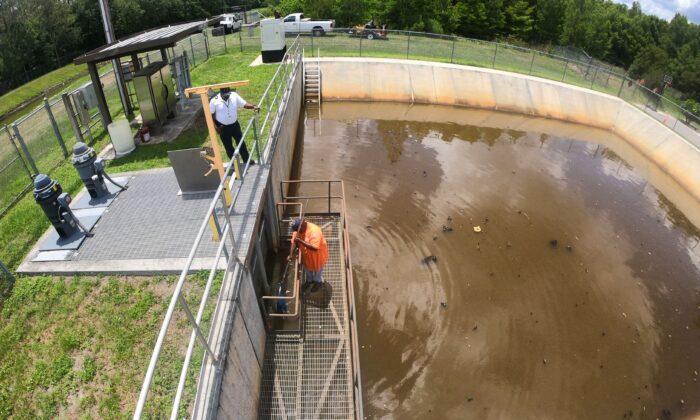FORT LAUDERDALE, Fla.—South Florida is now under a tropical storm watch as potential Tropical Storm Alex is expected to bring heavy rains and flooding to the state starting Friday evening through Saturday night, according to the National Hurricane Center.
It’s guaranteed to be a wet weekend in South Florida, according to the hurricane center, as the system approaching the state from the southeastern Gulf of Mexico now has a 90 percent chance of developing.
Forecasters anticipate that the system will become a tropical storm by Friday night. If it forms, it will be Tropical Storm Alex—the Atlantic’s first named storm of 2022.
All of South Florida also will be under a flood watch from midnight Friday through Sunday morning, the National Weather Service Miami said Thursday evening. The rain will hit South Florida starting Friday afternoon through Saturday night, forecasters said.
As of 8 p.m. ET Thursday, the system had maximum sustained winds of 35 mph and was moving north at 5 mph. It was 80 miles north-northwest of Cozumel, Mexico, and 500 miles southwest of Fort Myers.
The hurricane center predicted the system’s wind speeds will reach a maximum of 50 mph by Sunday evening.
But there’s some good news, too. The disturbance that was being watched near the Bahamas, off Florida’s east coast, remained at a near-zero chance of developing and was headed out to sea away from the United States.
“Considerable flash and urban flooding” caused by heavy, continual rain is the biggest threat from the system aiming toward Florida, forecasters say. The low pressure system could deliver between 4 to 8 inches of rain starting Friday and continuing through Saturday with maximum totals of 12 inches in some areas.
The system is expected to cross the state and into the Atlantic Ocean during the day on Saturday. It is expected to be heavily lopsided with the heaviest rain and strongest wind gusts to the east and south of its center, the National Weather Service said.
Fort Lauderdale and Miami are both included in the area expected to have the highest potential of flash flooding through Saturday, according to the National Weather Service. West Palm Beach has a moderate potential for flooding.
The briefing says potential impacts of the major flooding could be “possibly entering structures and cutting off neighborhoods” and that “flood control systems and barriers may become stressed.”
Fort Lauderdale Mayor Dean Trantalis had a message for residents at a news conference Thursday afternoon: “You will see flooding.” He urged people to start preparing for the busy hurricane season now.
“Especially low-lying areas, you’re going to see cars flooded out; you’re going to see driveways and streets impassable,” he said. “So please be careful, please make sure that you drive safely and if you live in one of those low-lying areas, try to find [an] alternative place to stay that night so that you can avoid any kind of disaster or emergency.”
The parking garages at Las Olas and in the central downtown areas are open free of charge for residents to try to protect their cars from floodwaters, Trantalis said.
Wind speeds Friday and Saturday have the potential to damage trees and powerlines and cause power outages. Isolated tornadoes are also possible late Friday and into Saturday, according to the National Weather Service Miami.
Tropical storm watches are also in effect for the west coast south of central Longboat Key, Lake Okeechobee, Florida Bay, six Cuban provinces and the northwestern Bahamas. On the east side of Florida, the watch extends from the Brevard/Volusia county line to the Florida Keys, including the Dry Tortugas.
Those watches mean the areas may experience tropical-storm-like weather in the next two days, according to the hurricane center.
Storm surges from Marco Island to Card Sound Bridge could reach between 1 and 3 feet, 1 to 2 feet from central Longboat Key to Marco Island and the Keys and Charlotte Harbor, forecasters said.
A system officially becomes a tropical storm when its maximum sustained winds are between 39 mph and 73 mph. Systems become hurricanes when the maximum sustained winds are 74 mph or greater.
“We kind of think the main thing that people need to focus on from this system is the rain, and it looks like the highest chance for flooding rainfall from this will be over the southern third of the state of Florida, so roughly anywhere from Naples to Vero Beach and on southward, that’s what appears to be at this point the most likely areas to see some very heavy rainfall,” said AccuWeather senior meteorologist Dan Kottlowski.
Fort Lauderdale will host a free sand bag distribution for residents from 8 a.m. ET to noon Friday at Mills Pond Park, 2201 NW Ninth Ave. There’s a limit of 10 bags per vehicle and residents should take their own shovel.
The City of Pembroke Pines is also offering a site for residents to pick up no more than six sandbags per car from the Howard C. Forman Health Park at 1001 Poinciana Drive and from the William B. Armstrong Dream Park at 1700 NW 160th Ave between 7 a.m. and 4 p.m. Friday. Shovels will be provided.
This is a La Niña year, meaning water temperatures will be warmer than usual and there’s less wind shear to tear apart storms.
Warm water temperatures are an optimal factor in tropical storm and hurricane development. In mid-June of last year, Tropical Storm Claudette formed in the Gulf waters and came ashore in Louisiana.
Current water temperatures are about one to two degrees higher than average for this time of year, AccuWeather Meteorologist Jake Sojda said, creating favorable conditions for the disturbance to develop.
Hurricane season officially starts June 1 and ends Nov. 30.
Floridians can buy supplies to prepare for this hurricane season free of sales taxes through June 10. Pet supplies are now included in the list of tax-free items.





